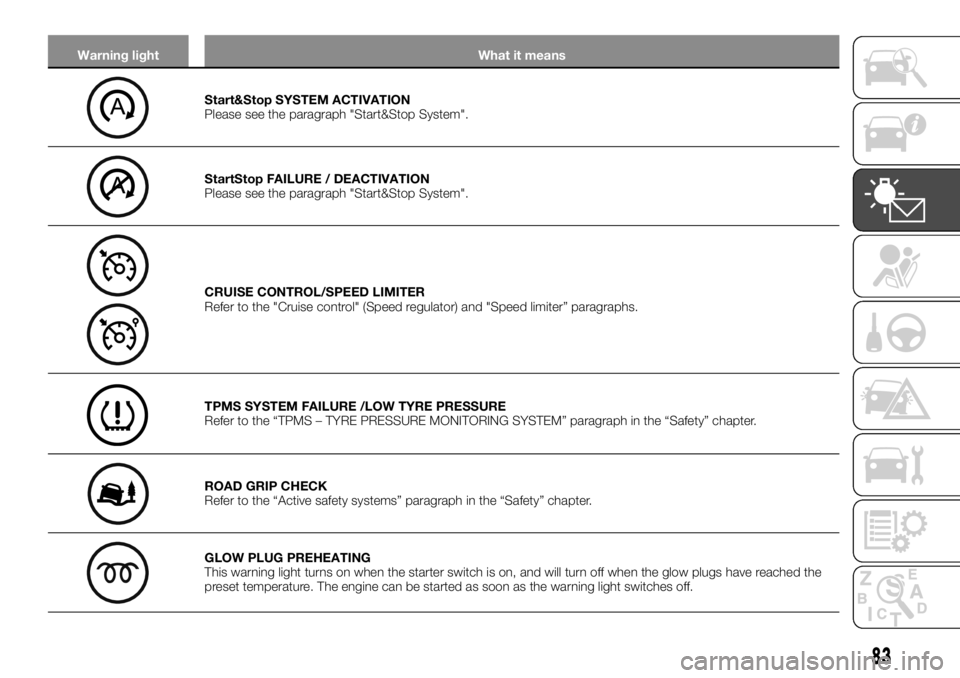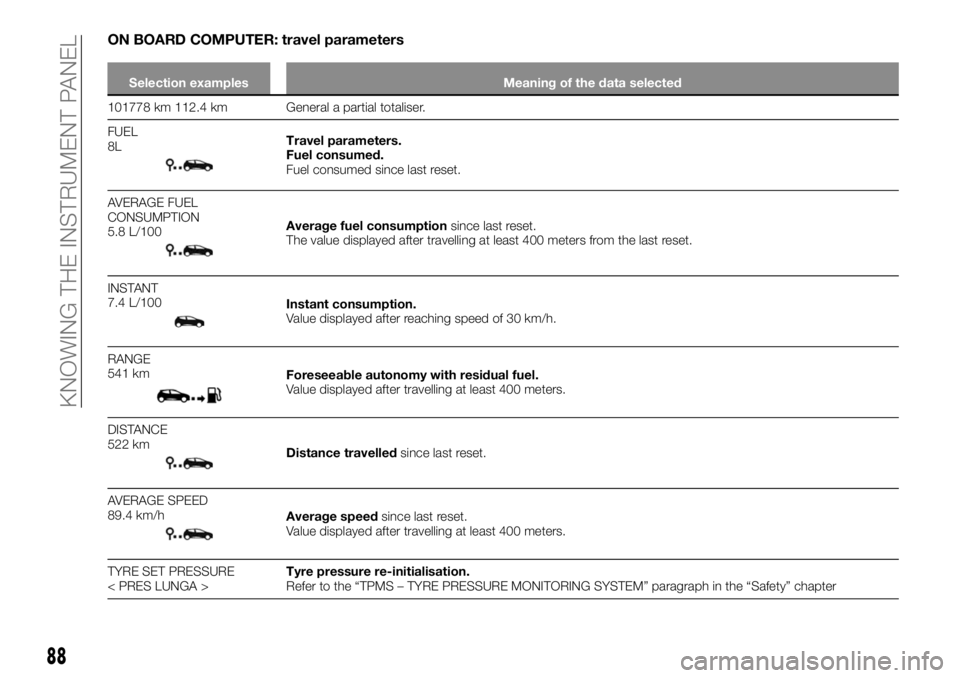reset FIAT TALENTO 2021 Owner handbook (in English)
[x] Cancel search | Manufacturer: FIAT, Model Year: 2021, Model line: TALENTO, Model: FIAT TALENTO 2021Pages: 236, PDF Size: 4.86 MB
Page 85 of 236

Warning light What it means
Start&Stop SYSTEM ACTIVATION
Please see the paragraph "Start&Stop System".
StartStop FAILURE / DEACTIVATION
Please see the paragraph "Start&Stop System".
CRUISE CONTROL/SPEED LIMITER
Refer to the "Cruise control" (Speed regulator) and "Speed limiter” paragraphs.
TPMS SYSTEM FAILURE /LOW TYRE PRESSURE
Refer to the “TPMS – TYRE PRESSURE MONITORING SYSTEM” paragraph in the “Safety” chapter.
ROAD GRIP CHECK
Refer to the “Active safety systems” paragraph in the “Safety” chapter.
GLOW PLUG PREHEATING
This warning light turns on when the starter switch is on, and will turn off when the glow plugs have reached the
preset temperature. The engine can be started as soon as the warning light switches off.
83
Page 89 of 236

CONTROL PANEL
AND ON-BOARD
INSTRUMENTS
On-board computer 1 fig. 172
Depending on the vehicle version, it
includes the following functions:
distance travelled;
travel parameters;
information messages;
malfunction messages (together with
warning lights
);
alarm messages (together with the
STOPwarning light).
Selection buttons for displaying
Scroll up (button 9) or down (button 10)
for the following information, pressing a
few times briefly (the display will depend
on the vehicle's equipment and country
of sale) fig. 173.You can view the following information
on the display screen:
overall and partial odometer for the
distance travelled;
fuel consumed;
average fuel consumption;
instantaneous consumption;
expected range with remaining fuel;
distance travelled;
average speed;
service limit, oil change counter;
tyre pressure re-initialisation;
speed set on the Cruise Control /
Speed Limiter;
time and temperature;
on-board log, information message
scrolling and operational malfunction;
percentage volume of remaining
additive.Resetting the trip odometer
When the "trip meter" display is
selected, press either button 9 or 10
fig. 173 until the odometer is reset to
zero.
Resetting travel parameters
When one of the trip parameters is
selected on the display, press button
9 or 10 fig. 173 until the display is reset.
Interpreting some of the displayed
values after resetting
The further you travel after the last
reset, the more accurate and significant
the average fuel consumption,
autonomy and average speed become.
During the first kilometres travelled after
resetting, you will notice that the
autonomy increases as you travel. This
is because the system takes the
average fuel consumption since the last
reset into account. The average fuel
consumption can decrease when:
the vehicle is no longer accelerating;
the engine reaches operating
temperature (reset: cold engine);
going from urban to extra-urban
driving.
Automatic travel parameter reset
Reset is automatic when one of the
parameter's capacities is exceeded.
172T36518
173T35570
87
Page 90 of 236

ON BOARD COMPUTER: travel parameters
Selection examples Meaning of the data selected
101778 km 112.4 km General a partial totaliser.
FUEL
8L
Travel parameters.
Fuel consumed.
Fuel consumed since last reset.
AVERAGE FUEL
CONSUMPTION
5.8 L/100
Average fuel consumptionsince last reset.
The value displayed after travelling at least 400 meters from the last reset.
INSTANT
7.4 L/100
Instant consumption.
Value displayed after reaching speed of 30 km/h.
RANGE
541 km
Foreseeable autonomy with residual fuel.
Value displayed after travelling at least 400 meters.
DISTANCE
522 km
Distance travelledsince last reset.
AVERAGE SPEED
89.4 km/h
Average speedsince last reset.
Value displayed after travelling at least 400 meters.
TYRE SET PRESSURE
< PRES LUNGA >Tyre pressure re-initialisation.
Refer to the “TPMS – TYRE PRESSURE MONITORING SYSTEM” paragraph in the “Safety” chapter
88
KNOWING THE INSTRUMENT PANEL
Page 142 of 236

A general grade from 0 to 100 appears
that allows you to assess your
ecological driving performance: high
values mean reduced fuel consumption.
Below is some ecological advice to
improve your performance. Store your
preferred routes lets you compare
performances. For further information,
refer to the RADIO/TOUCH – RADIO
NAV supplement.
ECOMODE
ECOMODE is a function that optimises
fuel consumption. It acts on a few of
the vehicle's uses (heating, air
conditioning, power steering, etc.) and
on a few driving operations
(acceleration, gear shift, speed
regulation, deceleration, etc.).
Activation of the function
Press button 4 fig. 225.
TheECOfig. 226 indicator light 5 on
the instrument panel turns on to
confirm that it has been activated.
While driving, you can temporarily leave
the ECOMODE function to reset all
engine performances.
To do this, press the accelerator pedal
firmly.
The ECOMODE function is reactivated
as soon as you release the accelerator.
Deactivating the function
Press button 4 fig. 225.
TheECOfig. 226 warning light 5 on the
instrument panel turns off to confirm
that it has been deactivated.BehaviourRather than heat the engine while
stopped, we advise you to drive
moderately until the engine reaches its
normal operating temperature.
Speed increases fuel consumption.
Do not strain the engine by
exceeding speed in intermediary gears.
Use the highest gear.
Avoid sudden acceleration.
Brake as little as possible. By
assessing the danger or curve in
advance, it will be sufficient to lift your
foot off the accelerator.
When going uphill, we advise you to
keep a steady speed, without having to
change it.
In modern vehicles, double clutching
before stopping the engine is not
necessary and could even cause
damage.Tyres fig. 227
Pressure too low can increase fuel
consumption.
Using unsuitable tyres can increase
fuel consumption.
Advice for use
Favour the ECOMODE function.
Electricity increases fuel
consumption. We advise you to turn off
accessories when they are not in use.
You must use your lights according to
the laws in effect in the country you are
in.
Use diffusers as much as possible.
Driving at 100 km/h with the windows
open increases fuel consumption by
4% fig. 228.
For vehicles with climate control, fuel
consumption is increased (especially in
cities) when in use. For vehicles with
manual climate control, turn off the
system when you no longer need it.
227T26528
228T31077
140
STARTING AND DRIVING